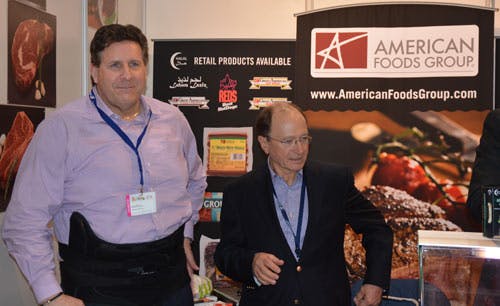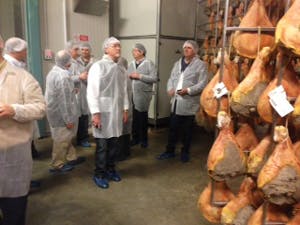U.S. Producers See Global Competitive Landscape in Market Expo

The Market Expo team saw evidence of intense global competition, both at Gulfood and in retail cases
The intensity of the global competition for red meat market share was brought home vividly for a dozen U.S. leaders of state and national agriculture organizations who recently completed a visit to the Middle East and Europe sponsored by USMEF.
The U.S. agriculture leaders attended the second-largest food industry show in the world, Gulfood in Dubai, where they met with U.S. exporters; saw the large-scale presence of competitors ranging from Australia, Brazil and India to Canada, Mexico and New Zealand; and received briefings on industry-supported marketing activities in the region.
The Market Expo agenda also included meetings with importers, processors and retailers, and opportunities to get insights into the import environment in the United Arab Emirates (UAE) as well as the European Union (EU).

Keith Obermiller (l.) of American Foods Group discusses U.S. red meat export opportunities with Wayne Humphreys, director on the Iowa Corn Promotion Board
“I was blown away by the choices at retail – the countries present at retail – from Australian beef to Brazilian to Indian,” said Kim Brackett, cow/calf and stocker producer from Buhl, Idaho, after the Dubai portion of the trip. Brackett, who also chairs the Cattlemen’s Beef Board, noted that U.S. beef stood out from its competitors based on its quality.
Iowa Corn Promotion Board Director Wayne Humphreys echoed Brackett’s sentiments, noting that competitors are anxious to fill a vacuum in the market whenever U.S. product is faced with access issues, as American pork and beef are currently restricted in Russia and U.S. beef continues to face a ban in Saudi Arabia.
“If we are to realize a gain from adding value to our cattle and hogs in the form of meat, we need to export that meat,” said Humphreys. “This is a market (Middle East) that is ripe for the picking for the export of high-quality U.S. beef.”
“What we saw in both regions is the competitiveness of countries wanting to be in the market,” said Mark Jagels, USMEF’s chairman who operates a diversified farm in south-central Nebraska where he produces corn and soybeans while custom feeding cattle. “In the EU, it’s a value-added market for producers who want identity-preserved product. In the UAE, as we see in any foreign market, it’s a worldwide game – very competitive – with product from Australia, New Zealand, Brazil, even Pakistani meat. It gives the consumer choices. Australia has put a lot of dollars into this (UAE) market. The competitiveness is unbelievable. We have to make sure we have a presence."

The USMEF team toured the Levoni prosciutto plant in Italy
While each export market has its own characteristics and challenges, the participants in the Market Expo team came away with agreement on the potential for growth of U.S. red meat exports, and the importance of maintaining a strong presence in the markets.
One of the key challenges, according to Wes Plummer, chairman of the Montana Beef Council, is educating consumers and the trade in these export markets about the value of U.S. red meat products.
“Educating the public is a key,” said Plummer. “I wish any local producers who are hesitant at all about spending checkoff dollars (in export markets) could come to one of these (Gulfood) shows and see how this sells our beef. It’s a true eye-opener.”
Humphreys, who noted that the current export premium for U.S. pork is $53.95 per head and $244.96 per head of fed beef slaughter, cited the importance of having a global presence to maintain strong American red meat exports.
“We saw people sitting at tables at Gulfood looking at purchase orders,” said Humphreys. “Individual producers – regardless of how much they have at stake back home – could not possibly make it happen half-a-world away to put buyers and sellers together. (Buyers) complimented USMEF for the possibilities they created putting buyers and sellers together. Our checkoff dollars work to make these shows possible and profitable for American farmers.”
Dan Halstrom, USMEF’s senior vice president for global marketing and communication, complimented the Market Expo team on their engagement and eagerness to learn about the two diverse markets.
“The real value of these Market Expos is helping American producers – representatives of our funding sources – see and better understand both the challenges and opportunities that the United States faces in the international market,” said Halstrom. “We are stewards of their checkoff dollars, so the better informed our members are, the better we can represent their interests.”
“The message we need to carry back home (to our members) is how hard their checkoff dollars are working for them overseas,” said Brackett.

Participants in the 2014 USMEF Market Expo included (l. to r.): Sam Funk — United Soybean Board; Judson Vasconcelos — Merck Animal Health; Mark Caspers — Nebraska Soybean Board; Wes Plummer — Montana Beef Council; Don Duvall — Illinois Corn Marketing Board; Robert White — United Soybean Board; Dan Halstrom — USMEF; Kim Brackett — Cattlemen’s Beef Board; Jackie Boubin, USMEF; Don Hutchens — Nebraska Corn Board; Annie Dee — United Soybean Board; John Brooks — USMEF; Wayne Humphreys — Iowa Corn Growers Association; Mark Jagels — USMEF Chairman; Don Murphy, Illinois Corn Marketing Board; Bassem Bousaleh — USMEF.
